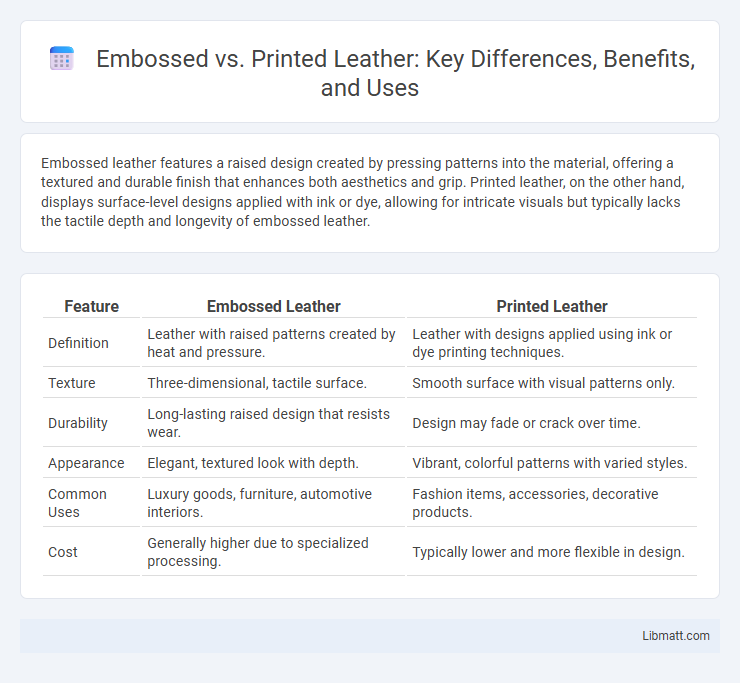Embossed leather features a raised design created by pressing patterns into the material, offering a textured and durable finish that enhances both aesthetics and grip. Printed leather, on the other hand, displays surface-level designs applied with ink or dye, allowing for intricate visuals but typically lacks the tactile depth and longevity of embossed leather.
Table of Comparison
| Feature | Embossed Leather | Printed Leather |
|---|---|---|
| Definition | Leather with raised patterns created by heat and pressure. | Leather with designs applied using ink or dye printing techniques. |
| Texture | Three-dimensional, tactile surface. | Smooth surface with visual patterns only. |
| Durability | Long-lasting raised design that resists wear. | Design may fade or crack over time. |
| Appearance | Elegant, textured look with depth. | Vibrant, colorful patterns with varied styles. |
| Common Uses | Luxury goods, furniture, automotive interiors. | Fashion items, accessories, decorative products. |
| Cost | Generally higher due to specialized processing. | Typically lower and more flexible in design. |
Introduction to Embossed and Printed Leather
Embossed leather features a raised texture created by pressing patterns into the surface, enhancing durability and adding a tactile dimension to your products. Printed leather, on the other hand, involves applying ink or dye directly onto the leather to create detailed designs or images, allowing for vibrant and customizable finishes. Understanding these differences helps you choose the right leather treatment for style and functionality in your leather goods.
What is Embossed Leather?
Embossed leather is created by pressing patterns or textures onto natural leather using heat and pressure, resulting in a raised design that mimics materials like exotic skins or intricate textures. This process enhances the aesthetic appeal while maintaining the durability and flexibility of genuine leather. Unlike printed leather, which applies ink or dye on the surface, embossed leather offers a tactile, three-dimensional finish that resists fading and wear over time.
What is Printed Leather?
Printed leather refers to leather that undergoes a process where designs, patterns, or colors are applied directly onto its surface using various printing techniques such as screen printing, digital printing, or transfer printing. This method allows for intricate and vibrant visuals without altering the leather's natural texture, making it ideal for customizing accessories, footwear, and upholstery. Your choice of printed leather enables a wide range of aesthetic possibilities while maintaining the material's softness and flexibility.
Key Differences Between Embossed and Printed Leather
Embossed leather features a raised or recessed pattern created by pressing a design into the surface, enhancing texture and durability, while printed leather involves applying ink or pigment directly onto the surface, allowing for intricate, colorful designs but with less tactile dimension. Embossing typically preserves the natural leather qualities and provides a more authentic, long-lasting finish, whereas printed leather offers greater design versatility but may be prone to wear or fading over time. The choice between embossed and printed leather depends on the desired aesthetic, texture, and longevity requirements for products like upholstery, fashion accessories, or footwear.
Durability Comparison: Embossed vs Printed Leather
Embossed leather features a textured surface created by pressing designs into the material, enhancing its durability by reinforcing the leather's structure and resisting wear over time. Printed leather, on the other hand, relies on surface pigmentation that can fade or peel with frequent use, making it less durable than embossed leather. When choosing Between embossed and printed leather, your decision should consider long-term durability, especially for high-use items.
Aesthetic Appeal and Texture Variations
Embossed leather features raised patterns created by pressing designs onto the surface, offering a tactile texture and intricate visual depth that enhances luxury and sophistication. Printed leather, by contrast, showcases vibrant designs applied via ink or dyes, providing endless customization options but maintaining a smooth texture without physical relief. The choice between embossed and printed leather hinges on desired aesthetic appeal--textured elegance versus vivid, flat imagery--with each method influencing the overall sensory experience of the leather product.
Common Uses of Embossed Leather
Embossed leather is widely used in fashion accessories such as wallets, belts, and handbags due to its textured patterns that mimic exotic hides like crocodile or snakeskin. It is also popular in upholstery for furniture and automotive interiors, providing a durable and visually appealing surface. Additionally, embossed leather is favored in bookbinding and stationery for its decorative and tactile qualities.
Popular Applications of Printed Leather
Printed leather is widely used in the fashion industry for creating vibrant, customized designs on handbags, shoes, and apparel, allowing brands to offer unique and eye-catching products. This technique also finds popularity in interior design, where printed leather upholstery adds bold patterns and textures to furniture, enhancing aesthetic appeal. In automotive manufacturing, printed leather is favored for car seat covers and dashboards due to its versatility in design and ability to replicate complex visuals.
Maintenance and Care Tips
Embossed leather requires gentle cleaning with a soft cloth to preserve its textured patterns, while printed leather needs careful cleaning to avoid fading or smudging the design. Use a mild leather cleaner suitable for both types, and avoid excessive moisture or direct sunlight to maintain durability and appearance. Your leather items benefit from regular conditioning to keep the leather supple and extend their lifespan.
Choosing the Right Leather for Your Needs
Embossed leather features a textured pattern pressed into its surface, offering durability and a unique tactile appeal, while printed leather provides vibrant, customizable designs through advanced printing techniques. Your choice depends on whether you prioritize longevity and subtle elegance or bold, intricate visuals for your project. Selecting the right leather ensures your product meets both aesthetic desires and functional requirements.
Embossed vs printed leather Infographic

 libmatt.com
libmatt.com